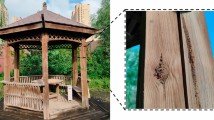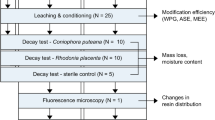Abstract
This study examined the effect of preservative treatment and wood drying history on paint primer cure and adhesion for New Zealand radiata pine (Pinus radiata D. Don). Double Vacuum LOSP treatments resulted in a significantly lower LOSP uptake than did Lowry treatments, for both sapwood and heartwood. Wood drying history had no effect on uptake by sapwood, but did affect uptake by heartwood; high-temperature-kiln-dried heartwood retained more solvent than air-dried or conventionally dried heartwood. For sapwood, LOSP treatment method and wood drying history did not significantly affect either primer cure or primer adhesion. For heartwood, primer adhesion in the early stage of cure was better with Double Vacuum treatments. Double Vacuum treatments also resulted in a higher cure of primer, two days after priming, than did Lowry treatment when either conventionally or high-temperature-kiln-dried heartwood was used, but no significant difference was found with air-dried heartwood. It was concluded that, for radiata pine heartwood, Double Vacuum treatment, combined with either air-drying or conventional drying, will reduce LOSP uptake and give better primer performance, so long as effective ventilated solvent removal is achieved before priming.
Zusammenfassung
In dieser Arbeit wird der Einfluß der Vorbehandlung mit Holzschutzmitteln und der Trocknungsgeschichte auf Aushärtung und Haftung eines Grundanstrichs auf Kiefernholz untersucht. Die zweimalige Vakuum-Imprägnierung mit Tributyl-Zinn in organischem Lösemittel (LOSP) brachte eine deutlich höhere Aufnahme in Splint- und Kernholz als die Lowry-Behandlungen. Die Art der Trocknung hatte keinen Einfluß auf die Retention im Splintholz. Das Kernholz nahm jedoch nach Hochtemperaturtrocknung mehr Lösemittel auf als nach Lufttrocknung oder konventioneller Trocknung. Bei Splintholz zeigte sich auch kein Einfluß der Behandlung und der Trocknung auf die Haftung und Aushärtung des Primers. Auf Kernholz war die Haftung nach zweifacher Vakuumbehandlung besser; auch die Aushärtung war nach zwei Tagen weiter fortgeschritten als nach Lowry-Behandlung, und zwar nach konventioneller und nach Hochtemperatur-Trocknung, nicht jedoch nach Lufttrocknung. Für Kernholz von Pinus radiata ist demnach eine doppelte Vakuum-Imprägnierung in Kombination mit Lufttrocknung oder konventioneller Trocknung zu empfehlen, da hierbei weniger Lösemittel aufgenommen und eine bessere Qualität des Grundanstrichs erreicht wird, wenn zuvor eine effektive Entfernung des Lösemittels durch entsprechende Belüftung gewährleistet ist.
Similar content being viewed by others
References
Double Vacuum British BWPA Standard 122: 1982. Specification for the application of organic solvent wood preservatives by-Double Vacuum
Kyte CT (1970) Over-painting of organic solvent preservative treated wood. In: Report of a symposium on painting wood treated with a preservative water repellent. Timberlab Paper No. 36. Forest Products Research Laboratory, Aylesbury, pp. 7–12
Kyte CT (1975) Compatibility of double vacuum impregnated timber with decorative finishes. British Wood Preservers’ Association National Wood Window and Door Association Industry Standard 2-93. Wood Windows. 4. Water Repellent Preservative Treatment of Millwork
Parkinson W (1985) Natural resin exudation in perspective. British Wood Preserving Association News Sheet No. 178 Standards Association of New Zealand: MP 3640:1992. Specification of the minimum requirements of the New Zealand Timber Preservation Council
Uprichard JM (1991) Chemistry of wood and bark. In: Kinninmonth J. A.; Whitehouse L. J. (eds) Properties and uses of New Zealand Radiata Pine. Volume i-Wood Properties. Chapter 4. New Zealand Ministry of Forestry, Forest Research Institute, Rotorua
Vinden P (1985) Optimisation of light solvent organic preservative (LOSP) treatment of radiata pine. New Zealand Wood Preservers’ Association, pp. 8772-104
Author information
Authors and Affiliations
Additional information
Koppers-Hickson Timber Protection (New Zealand) Ltd. supported this work.
Rights and permissions
About this article
Cite this article
Dawson, B.S.W., Nasheri, K. & Hong, S.O. Primer cure and adhesion after light organic solvent preservative treatment of Radiata pine. Holz als Roh- und Werkstoff 56, 247–251 (1998). https://doi.org/10.1007/PL00000077
Issue Date:
DOI: https://doi.org/10.1007/PL00000077




